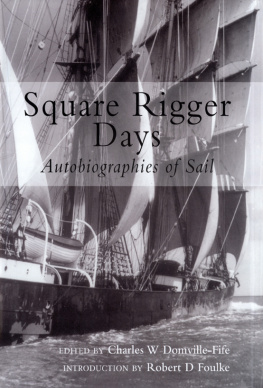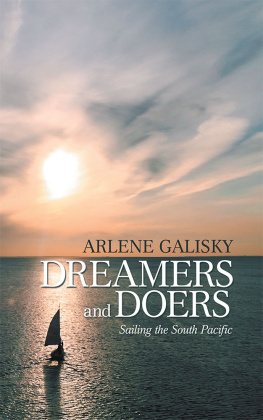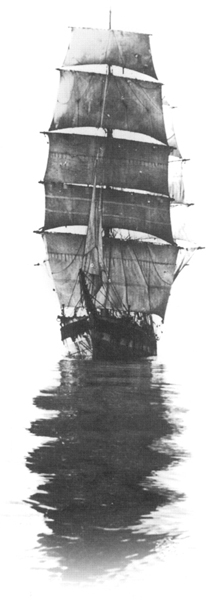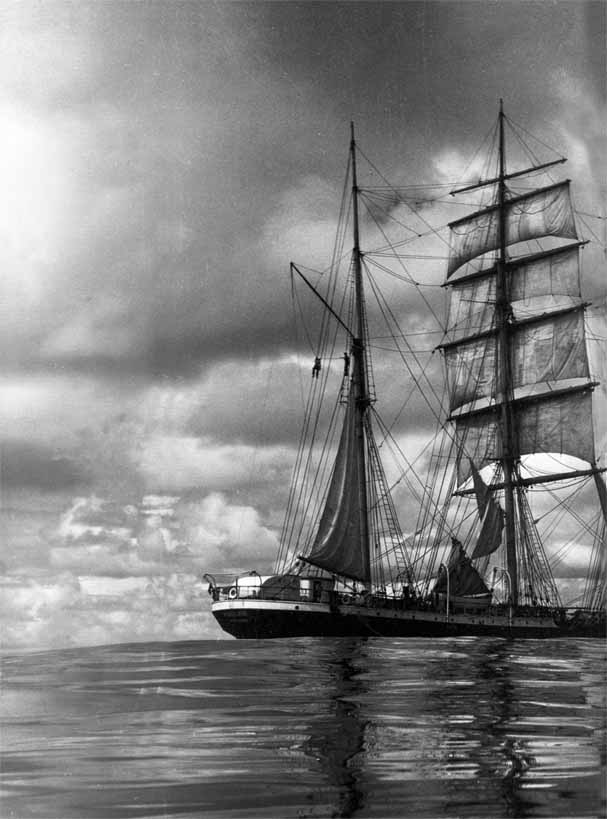SQUARE RIGGER DAYS
Square Rigger
Days
Autobiographies of Sail
EDITED BY Charles W Domville-Fife
INTRODUCTION BY Robert D Foulke
SEAFORTH PUBLISHING
The American three-masted barque Kaiulani becalmed in the Pacific, 1941, after she had carried the last load
of lumber under sail out of Grays Harbor, Washington State, bound for Durban. She was at sea when the Japanese
attacked Pearl Harbor and, engineless, unarmed and with no ships radio, sailed far south of Cape Horn to minimise
the risk of encountering Japanese shipping. From Durban she loaded cordite explosive and sailed to Sydney.
She was the last commercial square-rigged sailing ship to fly the Stars and Stripes.
Publishers Note & Acknowledgements
This new edition of Charles Domville-Fifes book, first published in 1938, includes an introduction by Robert Foulke which originally appeared in the Journal of British Studies, published by the University of Chicago Press. Some photographs from the original edition have been reproduced but the majority have been specially chosen for this edition. Most of these have been lent from the collection of David Clement whom the publishers would like to thank for his generous help and support. Photographs not from that collection have been credited accordingly. Despite extensive inquiries it has not been possible to trace the copyright holder of Square-Rigger Days. The publishers would be pleased to hear from anyone with further information.
This edition Seaforth Publishing 2007
Text copyright Charles Domville-Fife 1938
Introduction copyright The North American Conference on British Studies 1963
First published in Great Britain in 2007 by
Seaforth Publishing
An imprint of Pen & Sword Books Ltd
47 Church Street
Barnsley
S Yorkshire S70 2AS
British Library Cataloguing in Publication Data
Square-rigger days: autobiographies of sail
1. Seafaring life 2. Merchant mariners Biography
3. Sailing ships History 19th century
I. Domville-Fife, Charles W. (Charles William), b. 1886
941.45
ISBN 978 1 84415 695 5
All rights reserved. No part of this publication may be reproduced or transmitted in any form or by any means, electronic or mechanical, including photocopying, recording, or any information storage and retrieval system, without prior permission in writing of both the copyright owner and the above publisher.
Designed and Typeset by MATS Typesetters, Leigh-on-Sea, Essex
Printed and bound in Singapore
Contents
I F this book were only the personal reminiscences of the Editor it would have consisted of one story of youthful misery the answering of a call. It is, however, something far wider; and, moreover, it is intended to fill a very wide gap in the available literature of the sea.
There have been exhaustive works of great scholarship published during recent years describing and illustrating both the history of the sailing ship, that most beautiful creation of man throughout the ages, and of the great deeds of the men of sail, whose bravery, suffering, and endurance laid the foundations of commerce, Empire, and sea-power.
There has not been, so far as I know, any recent collection of personal stories by living seamen of their square-rigger days which combine to present a complete picture, in all its lights and shadows, and in all parts of the world, of the real life at sea as it was lived in those great days of sail, extending from the sixties of the nineteenth to the early years of the present century.
The illustrations have been collected over a period of many years, from all parts of the world, and themselves form a most complete collection of photographic studies of the ships and of life on board the old square-rigger in the days of sail.
It is a pictorial and descriptive record of personal reminiscences which must, in the nature of things, soon recede into history. Several of the authors have already reached the age of ninety years, and the white wings of memory will pass with them into the Valhalla of the Sea.
CHARLES W DOMVILLE-FIFE
Life in the Dying World of Sail,
18701910
B Y ITS BEAUTY and grace the sailing ship invites that nostalgic sentimentality often bestowed upon relics of the past. Visitors who notice the inscription on the Cutty Sark at Greenwich are asked to share this veneration: Here to commemorate an era the Cutty Sark has been preserved as a tribute to the ships and men of the merchant navy in the days of sail. They mark our passage as a race of men. Earth will not see such ships as these again. The image of the glorious last days of sail is largely the creation of retired seamen-writers. In an unfinished essay written just before his death in 1924, Joseph Conrad summarises the era of the sailing ship with typical nostalgia:
The last days of sailing ships were short if one thinks of the countless ages since the first sail of leather or rudely woven rushes was displayed to the wind. Stretching the period both ways to the utmost, it lasted from 1850 to 1910. Just sixty years. Two generations. The winking of an eye. Hardly the time to drop a prophetic tear. For the pathos of that era lies in the fact that when the sailing ships and the art of sailing them reached their perfection, they were already doomed. It was a swift doom, but it is consoling to know that there was no decadence.
Doom without decadence like the death of a beautiful woman in her prime is the seaman-writers usual elegy for the sailing ship.
Such homage to the sailing ship in its decline remains incomplete without its counterpart disparagement of the steamship. Old sailors could never forget that their paragon was being replaced by a tramp. Conrad again expresses the characteristic attitude:
Cargo steam vessels have reached by this time a height of utilitarian ugliness which, when one reflects that it is the product of human ingenuity, strikes hopeless awe into one. These dismal creations look still uglier at sea than in port, and with an added touch of the ridiculous. Their rolling waddle when seen at a certain angle, their abrupt clockwork nodding in a sea-way, so unlike the soaring lift and swing of a craft under sail, have in them something caricatural, a suggestion of a low parody directed at noble predecessors by an improved generation of dull, mechanical toilers, conceited and without grace.
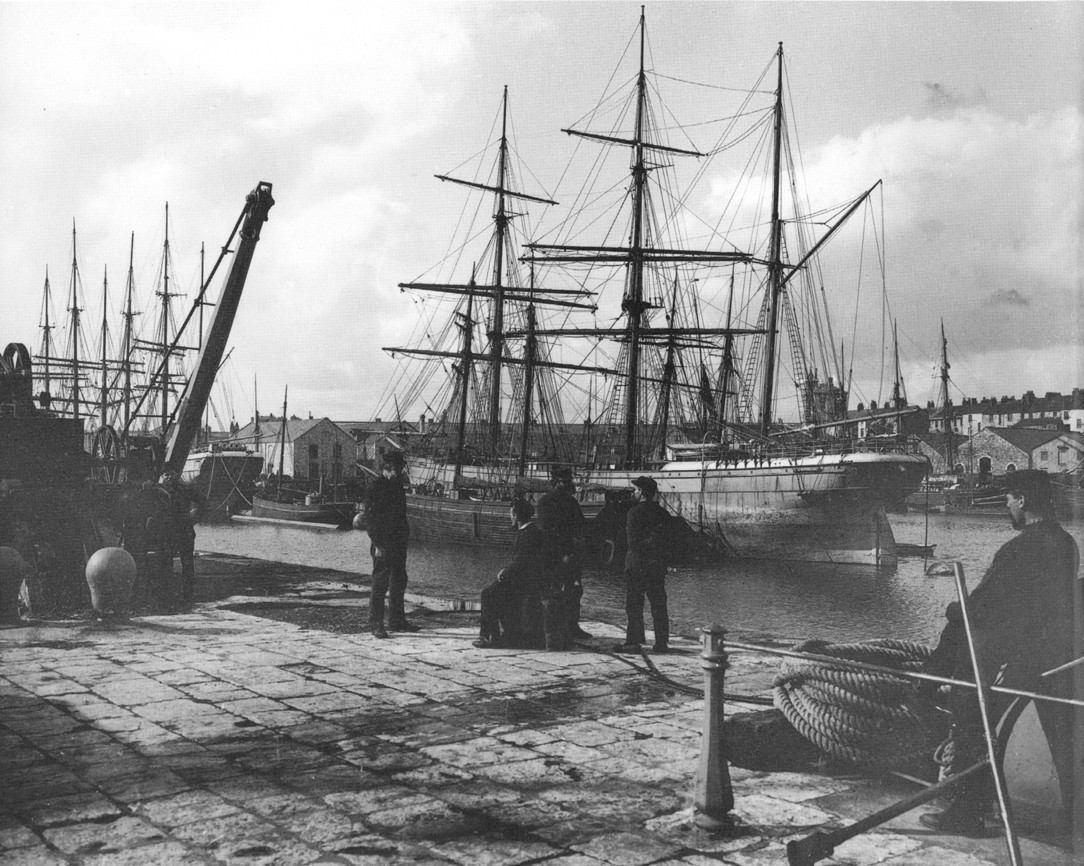
Some of the romance of the last years of the age of sail was stoked by the carefully-crafted black and white photographs of the period. Here, longshoremen idle away the time in this evocative photograph of Lowestoft docks taken at the turn of the century.
For men bred in sail, the steamship brought into life at sea both ugliness and the loss of a remote and specialised world of experience. Basil Lubbock complains that the calling of the Conrad further exaggerates the contrast between the worlds of sail and steam:
The hand of the engineer tore down the veil of the terrible beauty [of sailing ships] in order that greedy and faithless landlubbers might pocket dividends. The mystery was destroyed. Like all mysteries, it lived only in the hearts of its worshippers. The hearts changed; the men changed. The once loving and devoted servants went out armed with fire and iron, and conquering the fear of their own hearts became a calculating crowd of cold and exacting masters. The sea of the past was an incomparable beautiful mistress, with inscrutable face, with cruel and promising eyes. The sea of today is a used-up drudge, wrinkled and defaced by the churned-up wakes of brutal propellers, robbed of the enslaving charm of its vastness, stripped of its beauty, of its mystery and of its promise.

